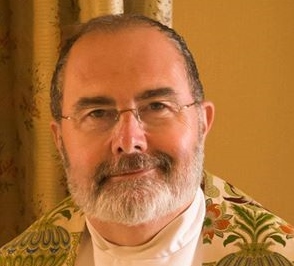Who Put Jesus on that Cross? – March 25, 2016
Posted on March 25, 2016 by admin No comments
Sermon preached by the Reverend Nicholas Lang
St. Paul’s on the Green, Norwalk, CT
Good Friday
March 25, 2016
Isaiah 52:13-53:12; Hebrews 10:16-25; John 19:17-24, 28-30, 38-42
In the Name of God: Creator, Redeemer, Sustainer. Amen.
Here we are again on the most haunting day of the church year come face to face with the cross, the crucified One and with ourselves. I suspect we can’t wait for all of it to be over so that we can move on to a new day that will bring brightness and festival celebration.
I have two distinct dramatic and poignant memories of the Good Friday Liturgy of the Orthodox Church : the “Nailing” —the chilling sound in a dark church of a hammer hitting the hard wood of a cross just before it is raised us for the congregation’s veneration to a haunting Byzantine melody and then the symbolic burial of Jesus in which an iconographic image of his body, first anointed by the priest with fragrant oil, is carried in solemn procession to a tomb in the center of the nave as the choir sings “The Noble Joseph,” the sweet Bulgarian chant we will hear at the very end of tonight’s service.
The most historically sound component of the Gospel is the passion and death of Christ. Sources from both the Christian community and outside of it name the person Jesus who was crucified in Jerusalem under the Roman procurator Pontius Pilate during the reign of the Emperor Tiberius. In fact, the suffering of Jesus might be the single most important proof of his humanity. What we likely struggle with is the question that has been the subject of theological study and individual speculation for centuries: Why did Jesus die? Who put Jesus on that cross?
My earliest exposure to this doctrine expressed in the Nicene Creed was my religious education in elementary school where well-meaning teachers explained the suffering of Jesus as payment for our sins—a concept difficult for an eight-year-old to grasp.
It is based on the teaching of 11th century Benedictine monk Anselm of Canterbury, who living in a medieval society, developed a theology of sin around the analogy of payment to a feudal lord. The sins of the world—offenses against God—could only be satisfied by a person of equal echelon —someone of the rank of God, namely Jesus Christ. It’s called the atonement and, quite frankly, it leaves us with an angry, vengeful, even calculating God.
How do we square that off with the God who is the Good Shephard, who welcomes the prodigal son, who counts the hairs on our heads, who when one asks for bread will not give a stone? That God did not want Jesus to die on the cross as payback for our transgressions. That God certainly did not design such a hideous plan. Jesus did not suffer because God planned it that way. He suffered because human beings designed it that way. The people he came to love, the structure he tried to stretch to it human limits and fullest potential, turned against him.
It was an ethos of fear and apathy and that lethal combination destroyed the one who came to teach us how to live, to show us what we can be in our full potential and how different the world might be when we treat one another as icons of the creator God.
Crucifixion ranks as one of the worst ways a person can die but we get the wrong image of God if we think that the death of Jesus was engineered by God for some morose theological payback for our sins.
What did put Jesus on the cross? It wasn’t God. It wasn’t the Jewish people. It wasn’t even Pilate. Love, mercy, justice, forgiveness, reconciliation, and peace. These things cost and they were the nails in the crucifixion of Jesus delivered by a society that refused to recognize the embodiment of Goodness, Integrity, and Righteousness in their very midst. And, if we are completely honest, we will admit that love, mercy, justice, forgiveness, reconciliation, and peace are still principles that cost—and accuse.
Curing lepers on the Sabbath, forgiving someone caught in adultery, eating with outcasts, calling for a distribution of wealth in the world, refusing to bear a sword, opposing systemic evil in both church and government, advocating for the marginalized—this is what put Jesus on the cross. They are the things that still put people on crosses.
I’m anxious as well to move on from the sadness and somberness of Good Friday. What dawns tomorrow and the next day will be much more palatable, especially as we recoil from the tragedy of the terrorist destruction in Brussels. What we must not forget before we leave the darkness of this night is that the love of God is stronger than the nothingness of death or of any other evil force in the world.
The healing of the nations will not come from systems where violence and personal power rules and where mercy and justice are disregarded, but from the persistent and abundant love that face them down. That love dispensed from our voice could make all the difference in the world.
The cross that we gaze upon tonight is not a pretty sight. We don’t find it an appealing image. Yet, as we look at the crucified Jesus—either from our seat or come forward to venerate this sacred symbol—we might ponder: given the milieu of our world, the mood of our nation, the barometer of compassion we might measure in our society, how would his story end if Jesus were living among us today?
